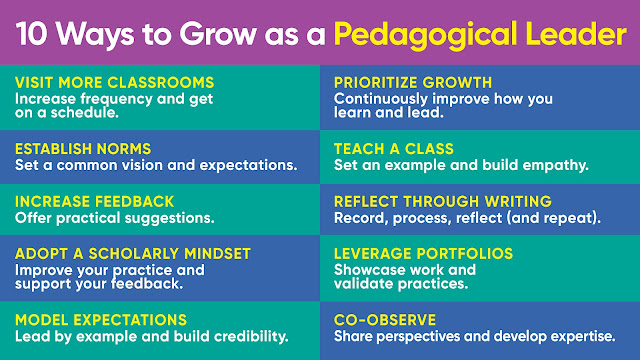10 Ways to Grow as a Pedagogical Leader
I have vivid memories of my early days as an assistant principal and principal, where overseeing instruction was just one of many duties that came with the job. Managing budgets, developing memos, attending meetings, responding to emails and phone calls, and other tasks also consumed a significant portion of my time. The advent of social media introduced yet another responsibility into my already packed schedule: digital leadership. As a school administrator, one must be proficient in many different areas, but it’s essential to maintain sight of the most crucial aspect of the role: pedagogical leadership.
Despite my best efforts, I couldn’t visit classrooms as frequently as I would have liked, and the feedback I provided in written reports could have done more to enhance teaching and learning both inside and outside the classroom. If our ultimate goal is to improve, we need to prioritize the aspects of our job that impact student learning most. Pedagogical leaders recognize that management is a necessary part of the job, but it shouldn’t come at the expense of cultivating a positive learning culture to boost academic achievement.
It’s simple to offer advice on improving in this area or anything else, but putting it into practice can be a constant challenge. To help you get started, I’ve compiled ten specific strategies that I used during my tenure as a high school principal and now help other leaders with during coaching cycles.
Visit more classrooms
Firstly, begin by increasing the number of formal observations conducted each year and sticking to a schedule to ensure that all teachers are observed three times annually, regardless of experience. Secondly, develop an informal walk-through schedule with your leadership team, mandating at least five walks per day for each member, and track visits and improvement comments on a color-coded Google Doc.
Establish norms
Establishing a shared vision and expectations for all teachers is crucial. You can do this by utilizing the Rigor Relevance Framework to provide them with consistent, concrete elements to focus on when developing lessons and deciding which high-effect strategies to use. Abolishing the routine of announced observations, having teachers provide artifacts of evidence to show the bigger picture since you can never see all that is done in a single observation, and prioritizing the collection assessments over lesson plans can also be effective.
Increase feedback
When observing lessons, always provide at least one practical suggestion for improvement, no matter how excellent the lesson was. These suggestions should be clear, straightforward, actionable, and timely. For learning, consider curating data weekly and present at an upcoming staff meeting. Feedback is critical to encourage growth and development.
Adopt a scholarly mindset
Improving professional practice as a leader is not the only benefit of being a scholar. It also enables you to have more effective conversations with teachers about their own growth, adding credibility to post-conference feedback. You can align critical feedback to current research by keeping a document of effective pedagogical techniques found in your readings. This approach saved time when writing up observations and improved relationships with staff as the instructional leader. When in doubt, lean on Google Scholar. Another key aspect of a scholarly mindset was brought to my attention by Thomas William Miller and that is to get curious and ask questions. When it comes to leading pedagogical change, questions are often more important than answers.
Model expectations
As I shared in Digital Leadership, leaders should lead by example and not ask teachers to do anything they wouldn’t do themselves, especially regarding technology integration and improving practice. When a teacher struggles with assessments, provide or co-create an example assessment. Developing and implementing professional learning is also an effective way to lead by example and build better relationships with staff.
Prioritize growth
Attending at least one conference or workshop a year that aligns with a significant school or district initiative and reading one education book and one from another field, such as general leadership strategies or self-help, can yield powerful lessons and ideas. Creating or further developing a Personal Learning Network (PLN) is also essential to access 24/7 ideas, strategies, feedback, resources, and support.
Teach a class
One can achieve this regularly throughout the year or by co-teaching with both struggling and exceptional teachers. I personally taught a high school biology class during my first few years as an administrator, which is an excellent example of leading by example. This approach also provides a better understanding of teachers’ changing role in the disruption age. When a pedagogical leader sets an example, it strengthens relationships with staff and puts them in a better position to discuss and enhance learning.
Reflect through writing
As a connected educator, writing has been a valuable tool for me to process my thoughts and critically reflect on my teaching, learning, and leadership work. Our reflections aid in our personal growth and serve as a catalyst for others to reflect on their own practice and develop professionally. Encouraging teachers to write brief reflections before post-conferences can foster a more collaborative conversation on improvement.
Leverage portfolios
Incorporating portfolios into our observation process was a helpful way to provide more detailed insight into pedagogical practices over the course of the school year. Portfolios can showcase personalized learning activities, assessments, unit plans, student work, and other forms of evidence to enhance instructional effectiveness and validate good practice.
Co-observe
During the first quarter of each year, I collaborated with members of my administrative team to co-observe lessons. This allowed us to benefit from each other’s perspectives and expertise and provided opportunities for us to improve our pedagogical leadership skills and reflect on our observations. In my role as a coach, I have K-12 leaders visit classrooms beyond the grade levels they serve when working with districts. For example, elementary will conduct walks in secondary to provide feedback and vice versa. We then share collective insight while processing the feedback. Gaining a perspective of strategies used at various grade levels is invaluable.
Ultimately, ensuring quality learning takes place in our classrooms is of utmost importance. These ten strategies can be implemented immediately to improve pedagogical leadership, but there may be additional strategies that others find effective. The image below provides further insight.








